For Mushroom Monday this week we bring you Trametes versicolor, also known as the ‘Turkey Tail’ fungus, so named as the banding pattern on this particular fungus resembles that of a wild turkey tail.
The Turkey Tail is often found on hardwood logs and stumps, and occasionally on conifer wood. Here the majority of Turkey Tail fungi seem to prefer decaying Tanbark (Lithocarpus densiflorus) and Live Oaks (Quercus agrifolia).
Trametes versicolor is a polypore fungus, and is one of the most common fungi that can be found in North American woods, but is also found worldwide. Polypores are important decomposers of wood within forest ecosystems.

Trametes versicolor is a polypore fungus. The pores are just visible on the under-surface of this specimen
Trametes versicolor is known for its brightly colored banding patterns, and this specimen is perhaps the most vivid colored Turkey Tail I’ve found here to date. The color of the bands can be somewhat variable (hence the name versicolor), but are generally dark to light brown bands, alternating with lighter white to tan. Occasional bands of orange, magenta, or blue are seen.
Trametes versicolor is often confused with the ‘False Turkey Tail’ fungus seen below (Stereum ostrea or Stereum hirsutum).
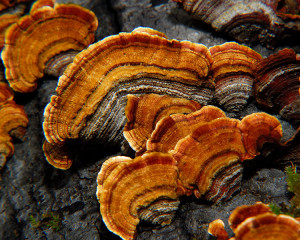
Stereum species have a similar banding pattern to Trametes, and are often mis-identified as true Turkey Tail fungi
Stereum species are crust fungi, not polypores. The principle feature used to distinguish Trametes from Stereum in the field, is that the underside of the ‘False Turkey Tail’ (Stereum) lacks a pore surface.
It is important when trying to identify these fungi that you examine the under-surface for the presence of pores. Otherwise their appearance is similar, including the banding pattern. The coloration of Stereum however, tends more toward orange, red and green in coloration. Stereum species are also occasionally parasitized by jelly fungi (see prior post on Tremella aurantia), whereas Trametes generally are not.
Both Trametes and Stereum species often catch a hiker’s eye because both can form extensive colonies on decaying hardwoods.
Occasionally, both Trametes and Stereum may even be found on the same log together.
Trametes versicolor is too tough to be considered edible. However, this fungus is proving to be of value medicinally. Trametes versicolor contains a protein-bound polysaccharide known as Polysaccharide-K (PSK). PSK, isolated from this fungus, has been shown in clinical studies to have anti-cancer properties, and may prove to be beneficial as an adjuvant treatment to aid in the prevention of recurrence of a range of common cancers [1,2].
The spore print of Trametes versicolor is white, and the brown pigments in this fungus may be extracted and used to dye paper, fabric and wool.
Hopefully, the next time you encounter these fungi in the forest, you’ll be better able to distinguish true Turkey Tail fungi, from False Turkey Tails.
[1] Standish LJ, et al. Trametes versicolor mushroom immune therapy in breast cancer. J Soc Integr Oncol. 2008 Summer;6(3):122-8.
[2] Hsieh TC, Wu JM. Cell growth and gene modulatory activities of Yunzhi (Windsor Wunxi) from mushroom Trametes versicolor in androgen-dependent and androgen-insensitive human prostate cancer cells. Int J Oncol. 2001 Jan;18(1):81-8.

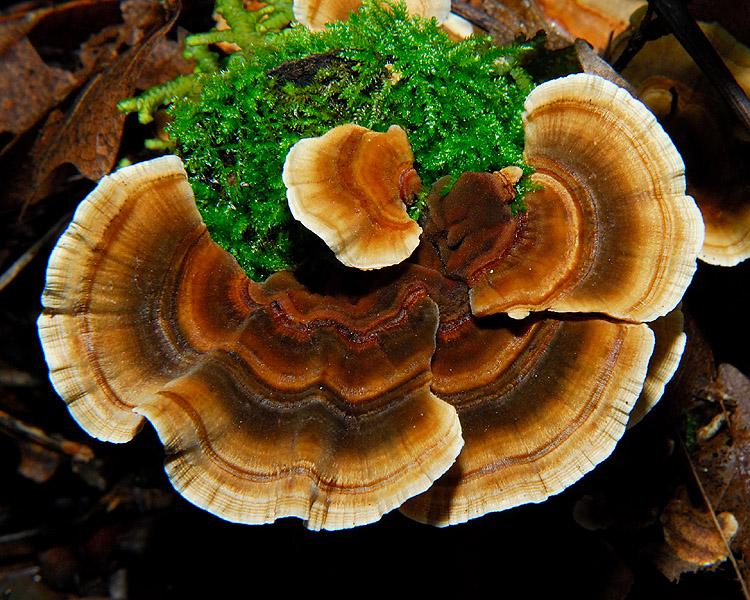
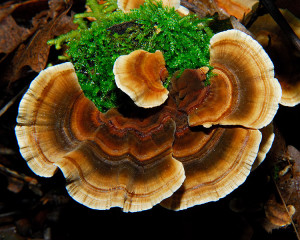
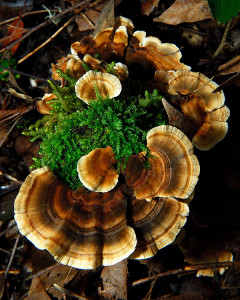
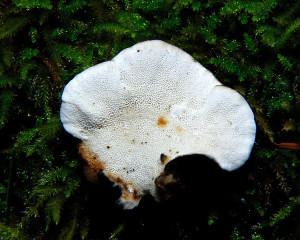
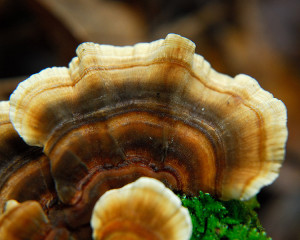
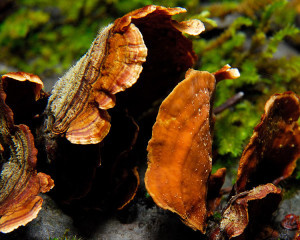

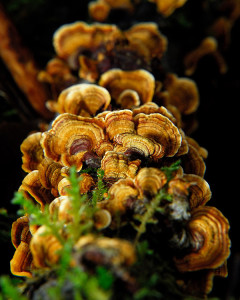
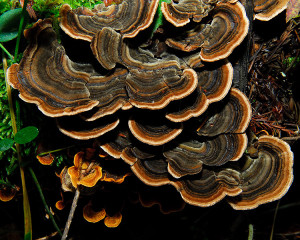







I love, love, love your Mushroom Monday feature 😀
I’ve seen that Turkey Tail before, and even though it’s common, it still looks pretty darn neat 😀
Oh, this was a wonderful post. I learned so much. I had no idea there were fungi that could be mistaken even for the common turkey tail. I posted a pic of some I found recently on my blog, and now I have no idea whether they’re the real or false ones — but I know where they are so I can go back and check soon. They were more greyish-green and slate-blue colored, although I’ve seen plenty of the brown and rust variety before.
I don’t know whether you accept links or not. If not, you may always delete it. 🙂
Here’s the link to my picture: http://victorygardenredux.wordpress.com/2010/02/04/turkey-tails/
Meredith, looking at your photograph, I would guess a False Turkey Tail, most likely Stereum ostrea. Tom Volk has a nice picture of that species, see:
http://botit.botany.wisc.edu/toms_fungi/nov2000.html
First picture, top left on that page is a Stereum ostrea. However, there is another species of Trametes, called Trametes hirsutum that can have a more grey-green color to it. The true test will be to pinch off a piece of your fungus, and examine it for pores!
This is wonderful … I am so glad to know what is what! Those Turkey Tails are just stunning and so like their namesake. I shall think of you and Meredith when next I glance upon a grouping! Your photos and narrative are perfect! A fabulous guide to mushrooms and fungi. ;>)
Very interesting! I had no idea.
Now, if I find these on living trees, is that a bad sign?
Town Mouse, apparently Trametes on living trees is more of a concern than Stereum sp., although I’m not an arborist. It’s my understanding that Trametes on living wood usually signifies stress, illness, or injury to the tree, and when present it can cause a spongy white-rot which can rapidly kill the cambium and cause die-back. Stereum however is rarely a cause of serious damage to living trees. If you have a living tree with Trametes, I’d call an arborist to see if they could identify the underlying problem.
I didn’t know it could look that pretty! 🙂
It’s very pretty, it kind of reminds me of a slice of a log with all the rings.
I really like your posts…
Here in Belgium, Trametes versicolor is a rather common fungus too.
Although the English name of the fungus is very descriptive, I prefer the Dutch one: ‘Elfenbankje’, to be translated as ‘Small elf’s bench’.
I love the colour variations in these. Thanks to your posts I’m going to be much more observant next time I’m in the forest. It will be interesting to see if I can spot any that are the same over here (although it sounds like you need a pretty trained eye to know for sure!) Heidi.
It is strange to think of fungus as beautiful, but the turkey tail is actually beautiful, with the brown and tan colors…
Amazingly cool! The colors really grab me!!!
Small elf bench sounds just about right! It’s like a lopsided mandala- your eye wants to find the center and never quite gets there. Maybe that’s why it’s so fascinating and hypnotic to look at!
The patterns of this mushroom are so beautiful! Thank you for all your interesting posts on mushrooms that have opened my eyes to these amazing and often overlooked plants!
These are great, I love mushroom Monday 🙂